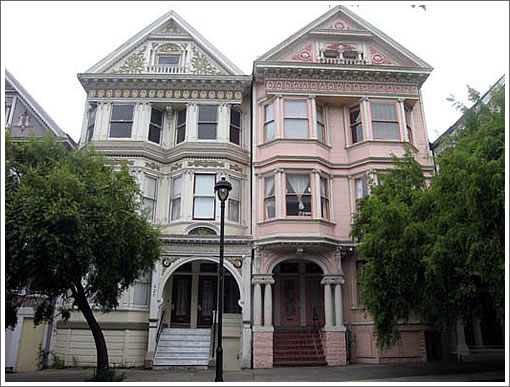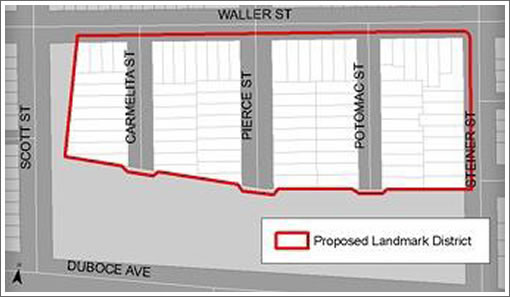
With 65 percent of the 34 surveyed property owners within the district in support, 29 percent opposed, and 6 percent indifferent, San Francisco’s Historic Preservation Commission is moving forward with plans to establish the Duboce Park Landmark District and the Article 10 Landmarking of 87 residential buildings along Waller, Carmelita, Pierce, Potomac and Steiner Streets.

The buildings within the district were built between 1899 and 1911 with nearly two thirds constructed in 1899 and 1900 due to the contentious history of the district’s development.
The district’s buildings display similar massing, materials, and uniform front yard setbacks that provide a cohesive streetscape of Victorian- and Edwardian-era residences. Generally speaking, the buildings fronting Carmelita, Pierce and Potomac Streets are single-family dwellings, while flats dominate the lots facing Waller and Steiner Streets. A few mixed-use properties are found in the district, such as the three-story flats-over-store building on the southwest corner of Waller and Steiner.
Buildings in the district range from 1 ½ story-over-basement to four stories in height, with two and three stories predominating. Mid-block buildings are typically smaller than those constructed at the corners or on Waller and Steiner Streets. These buildings are more likely to draw from Victorian-era form and massing such as prominent gabled roof forms and asymmetrical massing at the primary façade. The district’s largest single-family residences and flats were built on corner lots directly adjacent to the Park. These buildings are typically two- to three- stories in height and feature consistent detailing on the primary, park-facing, and rear façades.
Supporters of the [Landmark District] were asked to rank the reasons behind their support of the district. 96% of respondents indicated that protecting the visual and architectural character of buildings in the district was very important. Protecting the midblock park entrances was important or somewhat important to 87% of respondents. Providing “clear expectations and guidelines for myself and my neighbors in the review of future exterior alterations to the district” was very important to 70% of respondents and somewhat important to 30%. Bestowing neighborhood recognition was very important to 65%, somewhat important to 26%, and not important to 9% of participants. Improving property values or taking advantage of the Mills Act was very important to 39% and somewhat important to 52% of participants.
The top three ranked reasons for opposing the proposed designation were “opposition to any additional fees or review time for myself or my neighbors in the review of future exterior alterations” (93% of participants found this very important); “I have experienced or know of past negative experiences with the Dept. of Building Inspections or with the Planning Department” (85% of participants found this very important); and “I am opposed to government oversight of my property” (65% of participants found this very important, while 21% indicated it was somewhat important).
A bit of history for how the tract of land upon which the Duboce District ever came to be developed and the way in which the contested nature of the tract impacted the District’s physical appearance and connection to Duboce Park:
The tract (formerly known as the Public Reservation, Hospital Lot, and Marion Tract) was subject to a decades-long series of court battles over legal ownership, with the City of San Francisco losing half of its claim to the land to the German Savings and Loan Association in the late 1890s. After acquiring title to half of the tract, the bank subdivided the land, carved out interior block streets, and sold lots to builders who developed the residential portion of the tract. The lots sold quickly and a handful of builders immediately began developing the parcels.
Due to the delay in development caused by the litigation, construction dates for the vast majority of contributing resources within the district range from 1899 to approximately 1902. This short period of development and limited number of builders resulted in a remarkably uniform streetscape of Victorian- and Edwardian-era houses and flats of similar design and proportion. The contested nature of the tract, its history as a debris dump, and neighborhood activism and development of the adjacent civic park are key themes linked to the Duboce Park Landmark District.
One important visible manifestation of this interrelated history is found at the park’s northern border – specifically the lack of separation between the park and residential buildings. The district represents the best example of San Francisco’s handful of municipal parks that directly abut residential buildings, without any separation of a street or sidewalk. In addition, the historic stone steps and rock retaining walls at the three interior block park entrances – Carmelita, Pierce, and Potomac Streets – reflect the transformation of the City-owned portion of the contested tract from a dumping ground for Serpentine rock rubble to a picturesque, landscaped civic park. Serpentine rock rubble is also found in the foundations of many district buildings.
If approved by San Francisco’s Board of Supervisors, the Duboce Park Landmark District would become the twelfth landmark district within San Francisco, the eleventh of which is the Dogpatch Historic District which was designated in 2003.
Does this have any meaning?
The below crap is proposed/in process for Alamo Square “historic district” (McAllister, and “Painted Gentlemen” on Steiner).
Proposed Design And Planning’s Refinements For Alamo Square Infill
Rendering Scoop: Proposed For 802-808 Steiner Below Postcard Row
Just out of curiosity, does anyone know what percentage of this city is currently designated ‘historic’?
“Does this have any meaning?”
Hells yes. Want to modify your exterior? Or heaven forbid, add a garage?
Furgetaboutit!
(I mean, technically you can attempt these, but be prepared for a bureaucratic, as well as financial nightmare.)
I can’t wait for Space Mountain! Where’s Tomorrowland?
(and you guys wonder why MUNI sucks)
If you talk to people who are part of the Historic Preservation Commission or planners who are preservation specialists they will “imply” or suggest that the city is slowing moving toward making almost ALL neighborhoods an historic district.
This only creates more bureaucracy for remodeling your home, more costs, more delays and more restrictions.
I spent most of Christmas in Asia and the vibrancy, the sense of newness and of even more in the future is palpable in many cities there. Singapore has constructed an entire extension to the city on land that was ocean in the time we’ve mostly talked about making mid-market nicer. (Ok, finally some progress is being made there.)
Declaring most of the most banal architecture of the last century historic is beyond counter productive. I grew up where Washington crossed the Delaware river – real history during the American Revolution and there are fewer historic structures – and fewer restrictions on what we can do with them.
Are we really declaring that Victorians built directly adjacent to a park rather than on the other side of a road is historic in American architecture?
There is nothing historic about the west coast of the United States. Everything that was ever important happened in New England and the eastern southern states. These victorians are just photocopies.
@SF,
I’m actually not sure if that’s snark directed at me or if you are being serious.
But yes, we have the painted ladies and a few other historic buildings. We have a couple of historic streets.
All the rest is fair game.
There’s a very big difference between preserving the character of a city and protecting every 80 year old fire hazard slum from being knocked down and replaced with something better.
Does anyone know the history behind the irregular shape of the northern (and western) edge of the park? It seems as if something else was on that parcel before it was converted to a park.
I recall some sort of industrial smelter being in this area though thought that was in Eureka Valley or Noe.
Terrible Idea.
Approximately 35% of the property owners in the district (assuming one owner per property), and 65% of those like this idea. That’s only 23% of all the property owners in the district. And Planning defends their position with this pretense of a referendum???
The neighborhood all the way down to Church is already a potential historic district, requiring the HRE process for remodels of “potential contributors” no matter how banal.
For all the neo-marxists down at Planning, they sure know how to make the City more exclusive.
By Secretary of the Interior standards for National Historic Districts (this is not proposed nationally, so these standards don’t apply here, but still…) property owners not voting are counted as votes in support of historic designation. Under these standards, the vote in favor would be even more overwhelmingly for preservation.
This is probably the most historically intact area of housing in our city, and it’s pretty sad that most people here don’t think it’s worth preserving.
There are certainly plenty of old buildings in the city not worthy of preservation, but this neighborhood is in a class of its own, mainly due to the great preservation efforts of current and past property owners there.
Very, very little of San Francisco’s architecture is protected by a historic district, and I’m glad to see that changing in this small instance. I don’t remember what the percentage of the city currently designated historic is, but it’s very low, less than 1% if I recall.
A quick internet search reveals that there are only about 1110 protected parcels within the eleven designated historic districts in SF. That’s out of more than 200,000 parcels in the city. That’s about one-half of one percent. It’s pretty hard to make the claim that preservation runs amok in SF.
most of these homes, or any of historic value, are already protected under A class resources designations … or will be changed from B to A once any facade transformation is attempted. So why do you need the District Designation? This just throws all alterations right in front of the HPC and makes any attempt at changing any buildings not of historic value that much more difficult, and more blah blah designs like those new ones on alamo square that much more likely. Great job!
UPDATE: One Signature Away From Landmarking The Duboce Park District